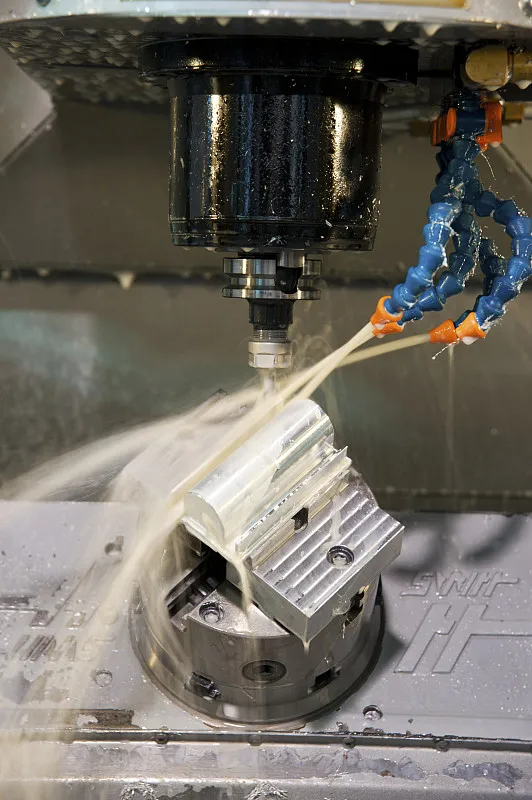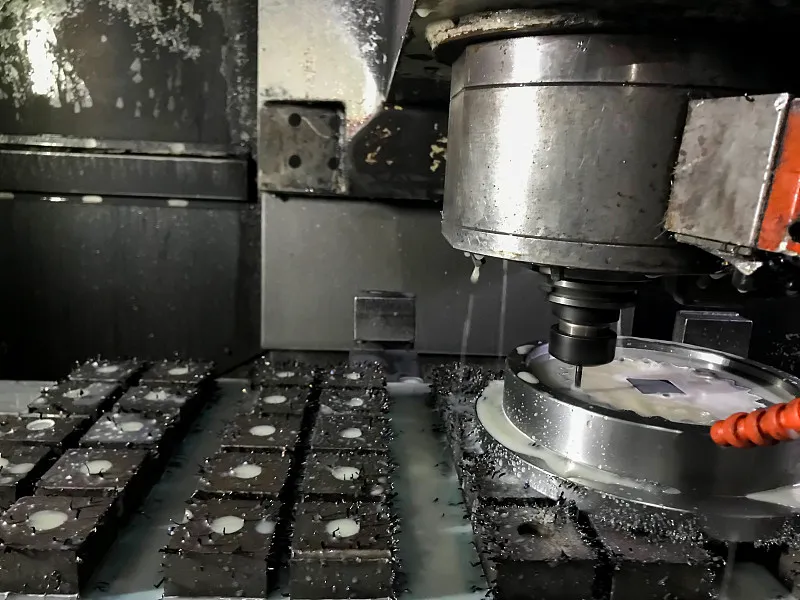CNC Milling Advantages and Disadvantages
CNC machining offers a multitude of fabrication and milling capabilities, making it a prevalent choice in diverse manufacturing industries. The versatility of CNC machining processes and milling makes it highly valuable for creating prototypes, fabricating mechanical components, and other applications. However, like any manufacturing process, it is not without its drawbacks.
In this article, Capable Machining will highlight both the advantages and disadvantages of the CNC machine and milling, so keep reading to learn more:
What is CNC Milling?

CNC milling is an automated process where a cutting tool is utilized to remove material from a workpiece. The setup involves securing the workpiece on the machine’s table, while the cutting tool is connected to the spindle and performs rotational movements to shape the workpiece into the desired final product. The precision and complexity of the cutting tool’s movements are determined by the specific type of CNC milling machine and the operator’s level of expertise. This versatile process is compatible with a wide range of materials, including plastics, aluminum, wood, and glass.
How Do Milling Machines Work?

The milling machine is a highly versatile machine tool capable of performing various tasks. It can handle tasks like processing planes (horizontal and vertical), creating grooves (keyways, T-slots, dovetail grooves), producing gear parts (gears, spline shafts, sprockets), crafting spiral surfaces (threads, spiral grooves), and shaping different curved surfaces. Additionally, the milling machine can be employed to process the surfaces and inner holes of rotating bodies and perform cutting operations.
During milling machine operations, the workpiece is mounted on the worktable or an indexing head along with other accessories. The main motion is generated by the rotation of the milling cutter, which is further complemented by the feed motion of the worktable or milling head. This combination of motions allows the workpiece to acquire the desired processing surface. The milling machine’s productivity is notably high due to its multi-edge intermittent cutting capability. In essence, a milling machine can function as a machine tool for milling, drilling, and boring various workpieces.
Applications of CNC Milling
CNC milling has a wide range of applications across various industries, thanks to its versatility and precision. Some of the key applications of it include:
Aerospace
CNC milling is extensively used in the aerospace industry to manufacture complex components for aircraft, satellites, and spacecraft. It allows for the production of lightweight and high-strength parts like turbine blades, engine components, structural elements, and landing gear.
Automotive
CNC milling is essential in the automotive manufacturing industry for producing engine blocks, cylinder heads, transmission components, and other intricate parts. It enables automotive manufacturers to achieve high precision and consistency in their products.
Medical
In the medical field, CNC milling is used to fabricate medical implants, surgical instruments, prosthetics, and other medical devices. The ability to create customized and patient-specific parts is particularly beneficial in this industry.
Electronics
CNC milling is employed to manufacture printed circuit boards (PCBs), which are essential components in electronic devices. It allows for precise routing, drilling, and milling of PCBs, ensuring the accuracy of electrical connections.
Mold Making
CNC milling is widely used in the creation of molds for plastic injection molding, die-casting, and other molding processes. The ability to produce intricate and precise molds leads to high-quality finished products.
Advantages of CNC Milling
CNC (Computer Numerical Control) milling offers numerous advantages that make it a preferred machining process method in modern manufacturing. Some of the key advantages of CNC milling include:
Increased Precision and Repeatability
The precision and consistency of it machines contribute significantly to enhancing your efficiency and productivity. With reduced errors and faster task completion of cnc milling operations, you can save valuable time and costs in the long run.
CNC milling machines boast impressive accuracy, ranging from 0.01 mm to 0.03 mm, ensuring precise results. Additionally, their exceptional repeatability, with tolerances typically between 0.003 mm to 0.01 mm, allows for consistent reproduction of parts, ensuring uniformity throughout the manufacturing process.
High-Efficiency
In conventional milling machines, the operator needs to manually change cutting tools for different cutting operations, leading to time-consuming and inefficient processes. The final results often rely on the operator’s judgment, which can introduce variability.
In contrast, CNC mills are equipped with rotating carousels capable of holding up to 30 different tools. These tools are automatically exchanged on the spindle during machining operations, enabling swift and efficient cutting processes. With CNC mills, parts can be ready in a matter of hours, whereas conventional methods using machining tools may take days or even weeks to complete.
Complex Geometries
CNC milling machines can create intricate and complex part designs that would be challenging or impossible to achieve with conventional machining methods. This capability opens up new possibilities for innovative product designs.
Reduced Cost
Cost savings stand out as a major benefit of milling machines due to their ability to rapidly and precisely manufacture parts without the need for costly tools or materials. Additionally, the operation of CNC machines can be efficiently handled by a single operator, reducing labor expenses.
For businesses or individuals working with wood, metal, or plastic, investing in a CNC milling machine is highly advantageous. Its incorporation can significantly enhance overall efficiency and productivity, making it a valuable asset to have.
Flexibility and Scalability
Easy Program Changes: CNC programs can be quickly modified to produce different parts or accommodate design changes, providing flexibility in production. Scalability: Suitable for both small-scale and large-scale production runs, making it ideal for prototypes as well as mass production .
Safety
Reduced Risk of Accidents: With minimal human intervention, CNC milling reduces the risk of workplace injuries associated with traditional machining. Controlled Environment: Machines operate in a controlled environment, minimizing exposure to hazardous materials and conditions.
Disadvantages of CNC Milling
While CNC milling offers numerous advantages, it also has some disadvantages that need to be considered in specific manufacturing scenarios. Some of the key disadvantages of CNC milling include:
Material Wastage
CNC milling follows a subtractive manufacturing approach, where a block of material is shaped by removing portions to create the final part. Due to this method, CNC milling generates more material wastage compared to additive manufacturing processes like 3D printing, which build parts layer by layer without significant material loss.
Initial Investment Cost
CNC milling machines can be expensive to purchase and set up, especially high-quality and advanced models. The initial investment can be a significant barrier for small businesses or individuals.
Complexity and Training
Operating and programming CNC milling machines require specialized skills and training. Skilled operators and programmers are essential to ensure smooth operations and accurate results. The learning curve can be steep, adding to the overall cost and time investment.
Maintenance and Downtime
Regular maintenance is essential to keep the machines running efficiently and accurately, involving tasks such as cleaning, lubrication, and component inspection. Proper calibration and alignment are necessary to maintain precision. Downtime, on the other hand, refers to the period when the machine is not operational due to maintenance, repairs, or unexpected breakdowns. Unplanned maintenance or breakdowns can result in costly downtime, impacting production schedules.
Software and Programming Errors
Errors in programming or software issues can lead to mistakes in machining, resulting in scrap parts and wasted materials. Proper verification and simulation are crucial to minimize such errors.
Limited by Machine Size
Workpiece Size Restrictions: The size of the workpiece is limited by the machine’s working envelope, which can restrict the types of parts that can be manufactured. Large Components: Producing very large components may require special machinery or alternative methods.
Conclusion
In conclusion, milling machines offer numerous advantages that justify their investment for businesses seeking precise cutting results. However, it’s essential to consider some disadvantages, such as setup times and maintenance costs, as well as slower speeds compared to alternative machinery like laser cutters or water jet cutters. The choice ultimately depends on the specific application – if accuracy takes precedence over speed, a milling machine might be the right choice.
Conversely, if faster results are needed, another type of machinery might be more suitable. Regardless of the decision, understanding both the pros and cons associated with any equipment will ensure an informed purchase that maximizes productivity for your business.